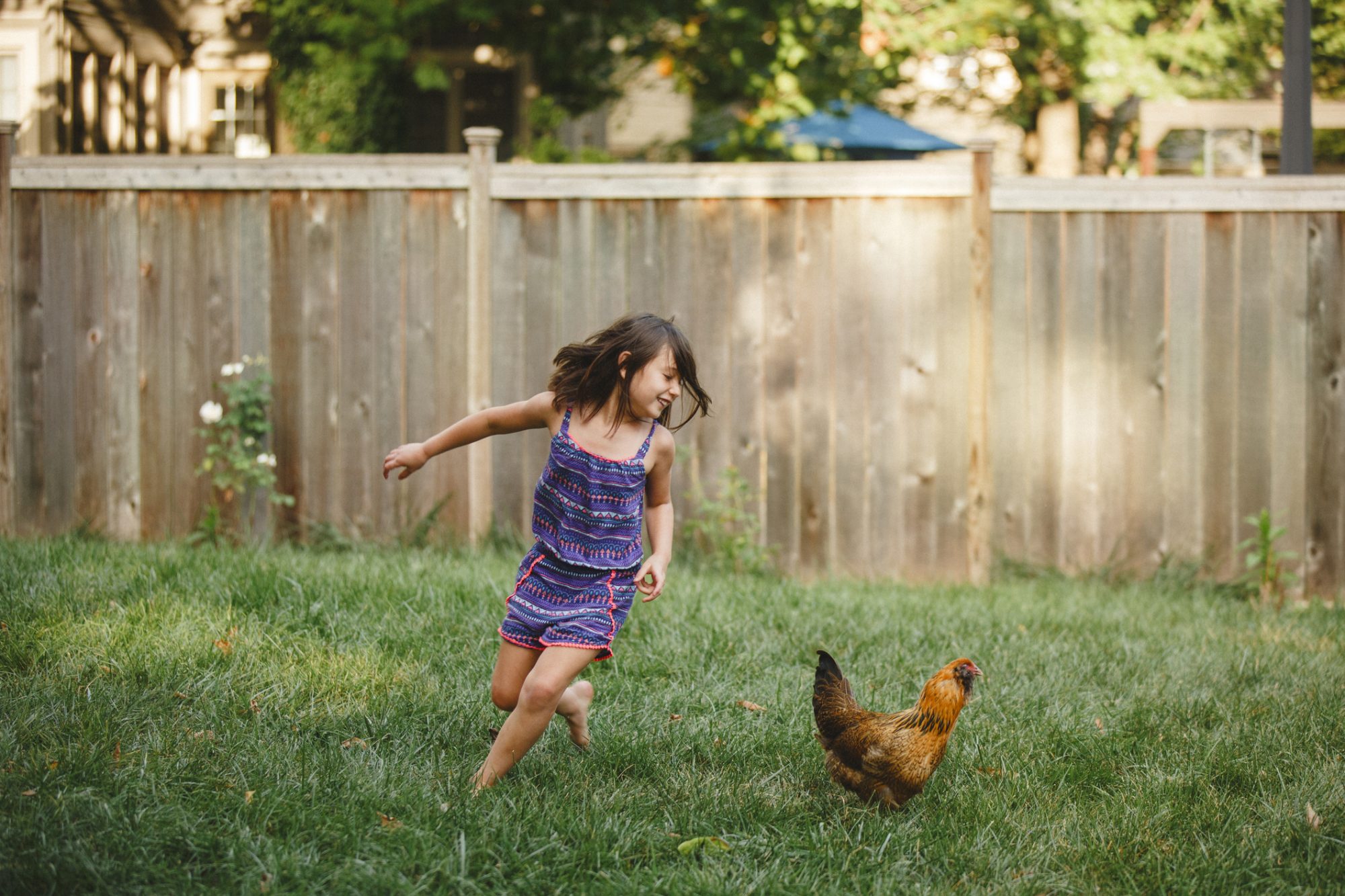
I decided I needed chickens. Many of our friends living near us in the suburbs of Seattle already owned chickens and one family we know had a hen so friendly that she sat on their laps and let them paint her claws with fingernail polish. It seemed every family with chickens had a cute story to share about their egg-laying pets. And the fresh eggs they shared with us were delicious.
I convinced my husband it would be a great experience for the kids and we would have sweet backyard pets and daily fresh eggs. The children swore they would take care of the hens. I even argued that having chickens would save us money! He remained skeptical but soon cracked under the pressure like a thin-shelled, store-bought egg.
Raising backyard chickens has become even more popular during COVID-19—reports show that backyard chickens are thriving during the pandemic. When done right, it's a great way to get fresh eggs and get the kids outside and even teaching them responsibility. But having backyard chickens wasn't nearly as easy as I imagined; it was a lot of work and costly. Here's what I wish I knew beforehand and tips for safely raising your own.
Raising Backyard Chickens
Baby chicks require a lot of care
We went to the feed store on Easter weekend (could I be any more cliché?) and let the three kids pick out one chick each. We rigged up a box with a heat lamp and thermometer and that's when I found out that baby chicks are a lot of work. You have to keep the temperature just right and adjust it often as they grow, or they will die. They knock over their water bowl multiple times a day, which means it needs to be refilled or they will get dehydrated and they will die.
Chicken coops are hard to clean
I bought a wooden coop online for cheap. It seemed perfect for our three chickens. However, it turned out to be really hard to maintain. The poop was everywhere. On the ramp to the nesting box and on the roof. It was disgusting and they really didn't have enough room to roam so they were walking around in their own excrement. My husband took pity on them and decided to build an enclosure around the coop from PVC pipe and plastic netting (that wasn't cheap). But we still had a lot to clean. A chicken's day goes like this: Step, scratch, peck, and poop. Repeat. All. Day. Long. And we had to watch where we stepped in the backyard and wash the kids' feet and shoes every time they came inside from playing outdoors.
One or more will turn out to be a rooster
One morning I heard it. Cock-a-doodle-doo—oh no! Yep, the aptly named Sunshine turned out to be a rooster. After a frantic phone call to the feed store, I found out that stores make no guarantee on the sex of chicks. They also won't take them back. Our HOA doesn't allow roosters so we had to figure out what to do with him. Our daughter wanted her beloved pet to go to a good home—not a stewpot. We finally found a guy who wanted another rooster for his brood and promised not to cook him for dinner and off Sunshine went, to live a long life on a farm.
Chasing chickens isn’t fun
While shopping for a nipple water feeder because the chickens were constantly knocking over their water bowl, an employee told me she was selling 5-month-old chickens. I bought one to replace the rooster that my daughter was still crying about losing. We named her Speedy because we soon found out that she ran really fast. Soon, every one of our neighbors was acquainted with Speedy. She was a master escape artist. In between calls from neighbors, I could be found running all over my backyard or trying to coax her down from the top of the swing set, the fence, a tree branch, anywhere that was mere inches beyond my reach.
They attract predators
Within a month, one of the kids noticed holes chewed in the netting of the enclosure. I was told by those wiser than me that it could be raccoons, possums, or rats. And one afternoon I heard the chickens raising a ruckus and looked outside to see a hawk sitting on a branch above the coop staring down his next tasty snack. Back to the hardware store I went, to get something to cover the top of the coop.
Chickens don’t always lay eggs
I vaguely remember someone telling me that hens didn't lay in winter. Fine, no eggs in winter—we knew that going in. But I was surprised to find out that chickens don't lay for other reasons. Like when it gets too hot in the summer, when hens go broody, or pretty much anytime they don't feel like it. This meant that although we occasionally got three eggs per day, we were still buying eggs from the grocery store.
Tips for Keeping Backyard Chickens
In the end, my family decided to rehome our chickens because it was just too much work. But for families who have the time, money, and energy, here are some tips from seasoned chicken owners.
Check local laws
Check the laws and regulations in your community. Many cities and HOAs prohibit roosters because of the noise and limit the number of chickens allowed. You don't want to get all set up and then get a letter from your neighborhood association!
Make sure there’s space
It's important you have enough room. The coop itself should have at least 3 square feet per chicken, plus 8 to 10 square feet per chicken for roaming. Also, scout your spot wisely. Don't put the run right along the fence next to your neighbor's deck, for example.
Know what to get
Hatching chicks is a great science project, but for first-timers, it might be a bit much. Starting with chicks from your local feed store is a less labor-intensive option. Of course, starting with young hens who are already laying is even easier, but some kids may want the babies. The bonus to starting with chicks is that they will get used to being handled early on, making for friendlier chickens.
Experts say some of the breeds best for beginners are Barred Rock, Rhode Island Red, and Araucanas. If you see chicks labeled as "straight run," you should, well, run! This means you get a 50 percent chance of a rooster. Choose "pullet" or "sexed" chicks. A rooster might still slip through, but it is less likely.
Get the right coop
Before you know it, those chicks will be big enough to leave the nest and go outside. Look for a basic coop that is easy to clean. Do look on Pinterest or other sites for ideas on upcycling a shed or other structure that you already have for your hens.
Make sure to also get the right setup if you're going for baby chicks. You'll need a brooder box, which is a safe, warm place for them to live. DIY versions are OK too. For heat, you can use a radiant heater or a heat lamp. If you do choose to use a heat lamp, make sure it is very secure since it can fall into the brooder and be a fire risk. A radiant heater is less of a fire hazard (make sure not to leave anything flammable near it) and works more like a mama chicken; the chicks go under it when they get cold.
Practice good hygiene
The Centers for Disease Control and Prevention (CDC) has seen a rise of outbreaks of salmonella illnesses recently, many due to keeping chickens. Chickens can carry salmonella, even if they look healthy. Salmonella causes severe diarrhea, fever, nausea, and abdominal cramps—none of which you want in your family. Make sure the kids wash their hands with soap after handling the chickens or doing any chicken chores. They also should be careful not to touch the chickens or anything in the coop and then touch their faces. Last but not least, tell them not to kiss their pets. Keeping a bottle of hand sanitizer near the brooder and coop can be a good reminder for everyone.
The CDC also recommends keeping chickens outside and keeping them away from kids younger than 5, adults older than 65, and anyone with weakened immune systems.





